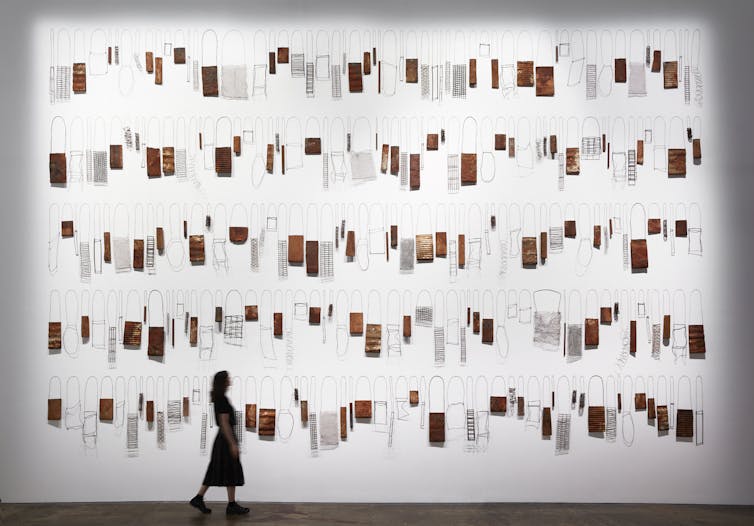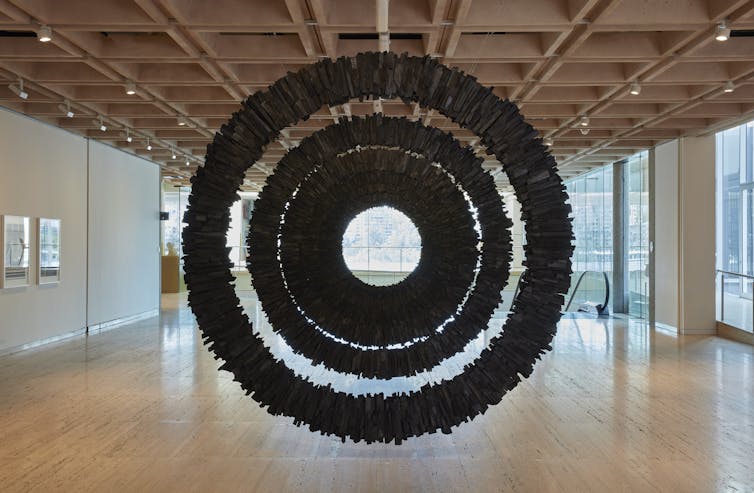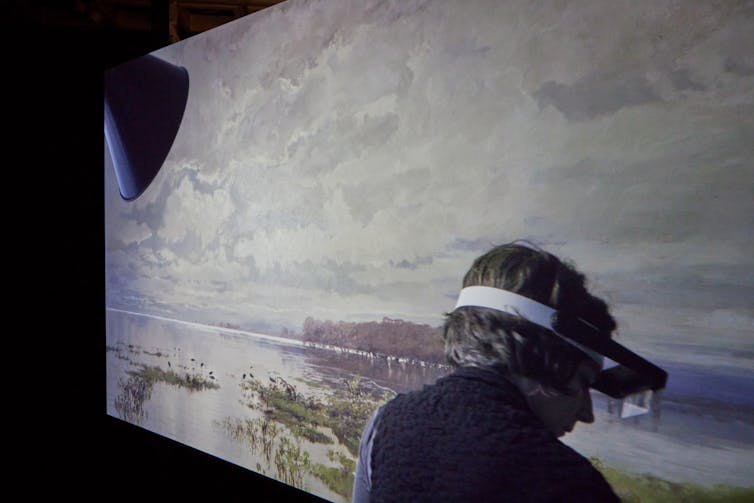The National 2021 highlights care in Australian art
- Written by Felicity Fenner, Associate Professor at UNSW Art & Design, UNSW
Given the restrictions on international borders as a result of COVID-19, it is convenient The National has always been dedicated to the work of Australian artists.
Launched in 2017 as a series of three biennial exhibitions, The National treads a fine line between celebrating the work of local artists and proffering theories of a cultural homogeneity known as “Australian art”.
Australia’s heightened sense of distance from the world in 2020 threatened to amplify this tension. Instead, the exhibition presents a sophisticated and worldly response to social concerns with a return to the role of the curator as one of care.
Presented across the MCA, the Art Gallery of NSW and Carriageworks, work by 39 artists and artist teams are woven together by themes of environmental catastrophe, racial inequality and non-Western cultural traditions.
 Lorraine Connelly-Northey, ‘Narrbong Galang’ 2021. Installation view ‘The National 2021: New Australian Art’ Carriageworks.
Photo credit Zan Wimberley. Image courtesy and © the artist
Lorraine Connelly-Northey, ‘Narrbong Galang’ 2021. Installation view ‘The National 2021: New Australian Art’ Carriageworks.
Photo credit Zan Wimberley. Image courtesy and © the artist
From the Art Gallery of NSW, with Fiona Hall’s graveyard of charred trees and books bearing the names of lost species, to the depictions of regenerative ecosystems in North-Eastern Arnhem Land by the late Mulkun Wirrpanda at the MCA, the exhibition ebbs and flows between despair and hope, anger and optimism.
Stories of fire and water
Hall’s bleak memorial in the gallery’s vestibule — a response to last year’s bushfires — is answered at the far end of the entrance court by Wona Bae and Charlie Lawler’s chain of concentric charcoal circles suspended at eye height, inviting spiritual connection to cycles found in nature.
 Wona Bae, Charlie Lawler, ‘Regenerator’ 2021, charcoal, glue, steel, sound, installation dimensions variable.
Courtesy the artists © the artists Photo: AGNSW, Diana Panuccio
Wona Bae, Charlie Lawler, ‘Regenerator’ 2021, charcoal, glue, steel, sound, installation dimensions variable.
Courtesy the artists © the artists Photo: AGNSW, Diana Panuccio
Positioned between these invocations of fire, two expansive paintings by Australian First Nations artists Betty Muffler and her niece Maringka Burton establish a narrative about the land, revealing the life-giving natural systems of the Anangu Pitjantjatjara Yankunytjatjara (APY) lands in South Australia.
This watery theme extends to Judy Watson’s nearby canopy of floating canvases, capturing the flow of Sydney’s now degraded Tank Stream.
Continuing the elemental themes of fire and water, downstairs Gabriella Hirst’s double-sided film installation laments the care afforded to paintings, but not bestowed on the land they depict.
One side of the screen shows a hypnotically living landscape, a section of the Darling River gradually running dry. On the reverse side, a team of conservators work painstakingly on one of the gallery’s most famous historical paintings, Piguenit’s The flood in the Darling, 1890 (1895).
The clinical noises of their tools in the laboratory rudely interrupt the harmonious birdsong from the landscape.
 Gabriella Hirst ‘Darling Darling’ (installation view) 2021, 2-channel HD video installation, stereo sound, colour, 25:26 min Courtesy the artist, the Ian Potter Cultural Trust and the Australian Centre for Moving Image (ACMI).
Commissioned by the Ian Potter Cultural Trust under the Ian Potter Moving Image. Commission for exhibition by the Australian Centre for Moving Image (ACMI) © the artist Photo: AGNSW, Felicity Jenkins
Gabriella Hirst ‘Darling Darling’ (installation view) 2021, 2-channel HD video installation, stereo sound, colour, 25:26 min Courtesy the artist, the Ian Potter Cultural Trust and the Australian Centre for Moving Image (ACMI).
Commissioned by the Ian Potter Cultural Trust under the Ian Potter Moving Image. Commission for exhibition by the Australian Centre for Moving Image (ACMI) © the artist Photo: AGNSW, Felicity Jenkins
The irony of the level of care between each sequence of footage is echoed in the dualistic presentation. We are forced to choose one side or the other: Western culture’s blinkered view of the land, or care for Country.
Care of culture
Phaptawan Suwannakudt’s painterly appropriations of historical propaganda posters reflect on the recent protests staged by young people in Thailand, critical of the monarchy and the prime minister.
 Phaptawan Suwannakudt ‘RE al-re-g(l)ory’ 2021 acrylic on canvas, plyboard, fabric, installation dimensions variable.
Courtesy the artist © the artist Photo: AGNSW, Felicity Jenkins
Phaptawan Suwannakudt ‘RE al-re-g(l)ory’ 2021 acrylic on canvas, plyboard, fabric, installation dimensions variable.
Courtesy the artist © the artist Photo: AGNSW, Felicity Jenkins
Pakistani-Australian artist Abdullah M.I. Syed’s intimate and highly moving homage to his late mother uses everyday items arranged on the wall in a celestial pattern: kitchen crockery, reading glasses, the hand-sewn bags in which she kept each of her children’s passports.
These earthly vestiges of his mother’s life are presented alongside a confronting film of his mother on her deathbed.
The outstanding project at Carriageworks is a collaboration between Queensland Aboriginal artist Vernon Ah Kee and Yawaru dancer Dalisa Pigram.
Ah Kee has created an immersive three-screen video installation of Pigram’s award-winning solo performance, Gudirr Gudirr, restaged against the ocean and on the streets of Broome.
 Vernon Ah Kee, Dalisa Pigram & Marrugeku, ‘Gudirr Gudirr’ 2021. Installation view ‘The National 2021: New Australian Art’, Carriageworks.
Photo credit Zan Wimberley. Image courtesy the artists, Marrugeku Inc and Felix Media Pty Ltd © the artists, Marrugeku Inc and Felix Media Pty Ltd
Vernon Ah Kee, Dalisa Pigram & Marrugeku, ‘Gudirr Gudirr’ 2021. Installation view ‘The National 2021: New Australian Art’, Carriageworks.
Photo credit Zan Wimberley. Image courtesy the artists, Marrugeku Inc and Felix Media Pty Ltd © the artists, Marrugeku Inc and Felix Media Pty Ltd
In her vigorous, fluid movements and spoken word, Pigram embodies the anger and exhaustion of generations of displaced and disadvantaged communities in the Kimberley. Ah Kee’s characteristic text and portraiture is expertly sewn into the footage, resulting in a stirring declaration of strength and resilience.
Art of contemporary politics
Unlike international exhibitions, such as the Biennale of Sydney and the NGV Triennial, in including only Australian artists The National has the potential to provide a snapshot into Australia’s recent social preoccupations.
Read more: Enthralling, dystopian, sublime: NGV Triennial has a huge 'wow' factor
However, this assumes contemporary artists are attuned to current affairs and are willing to interpret, propose alternative readings, or take a visionary stance. Many are not.
But at this year’s National, a new generation of politically-engaged curators have selected art with meaning beyond the gallery walls. The result is a globally informed and often insightful contribution to the prevailing discourse, by artists living and working in Australia today.
Authors: Felicity Fenner, Associate Professor at UNSW Art & Design, UNSW





